Analog modeling is based on the digital replication of the analog synthesis, i.e. the emulation of original electric circuit behavior and revival of that waveform with the help of software algorithms and adequate hardware – DSP (Digital Signal Processing). In analog modeling type synthesizer a sound wave is reproduced by a digital generator and goes through digital processing path as well.
“Virtual analog” is still a king of analog modeling, though it’s often used as a definition for a budget or simplier technology introduced in a synth – this sort of synthesis usually implies editing and processing of ready-made waveform and noise samples which is definitely not a dynamically generated waveform in real time as you get it in expensive analog modeling instruments but an offer of already recorded basic waveforms – sine, triangle, square and others.
Unlike original analog synthesizers, analog modeling instruments often feature a much bigger choice of waveforms as well as much bigger set of signal modulation possibilities. These obvious advantages and the intention to give musicians a wider polyphony, factory and user preset options while keeping the price reasonable, a synth - compact and a quality – satisfying pushed the instrument making companies to develop such kind of systems in the early 1990s.
 The first analog modeling synthesizer is considered to be Clavia Nord Lead released in 1995. It was a multitimbral instrument with the polyphony increase possibility (from 4 to 12 voices) which was capable of repeating the sounds of the best analog synthesizers of the past. The synth featured all the basic functions which used to be intrinsic to analog instruments – virtual generators, LFO, filters, envelope generators, and even more: a much more diverse arpeggiator and a unique Morph function which became a №1 function of the keyboard. The red beast was adored by many of the bands and musicians: Depeche Mode, The Prodigy, Nine Inch Nails, The Crystal Method, Fatboy Slim, ATB and others.
The first analog modeling synthesizer is considered to be Clavia Nord Lead released in 1995. It was a multitimbral instrument with the polyphony increase possibility (from 4 to 12 voices) which was capable of repeating the sounds of the best analog synthesizers of the past. The synth featured all the basic functions which used to be intrinsic to analog instruments – virtual generators, LFO, filters, envelope generators, and even more: a much more diverse arpeggiator and a unique Morph function which became a №1 function of the keyboard. The red beast was adored by many of the bands and musicians: Depeche Mode, The Prodigy, Nine Inch Nails, The Crystal Method, Fatboy Slim, ATB and others.
 The best Japanese brands got into the mainstream quick enough. Korg was the first – it presented a monophonic synthesizer called Prophecy and the project grew into a 12-voice Z1 (1997) offering an extension possibility up to 18 voices (you could use an expansion card). Both Korg synthesizers were based on the OASYS project designs – MOSS (Multi-Oscillator Synthesis System) technology and VPM (Variable Phase Modulation). These instruments offered a wide waveforms choice, all the main filter types (Prophecy had LPF, HPF, BPF; BRF) while Z1 featured a great variety of effects. MOSS virtual modeling technology was available to such iconic instruments as Trinity and Triton in the form of expansion cards.
The best Japanese brands got into the mainstream quick enough. Korg was the first – it presented a monophonic synthesizer called Prophecy and the project grew into a 12-voice Z1 (1997) offering an extension possibility up to 18 voices (you could use an expansion card). Both Korg synthesizers were based on the OASYS project designs – MOSS (Multi-Oscillator Synthesis System) technology and VPM (Variable Phase Modulation). These instruments offered a wide waveforms choice, all the main filter types (Prophecy had LPF, HPF, BPF; BRF) while Z1 featured a great variety of effects. MOSS virtual modeling technology was available to such iconic instruments as Trinity and Triton in the form of expansion cards.
 In 1996 Yamaha CS1x was demonstrated – it was a synthesizer quite popular among electronic musicians as well as among hip hop, house, techno and dance musicians in the late 1990s. So it’s hard to say whether it’s a virtual analog, because it’s more of a big digital synthesizer based on samples which replicates the circuit logic of analog instruments. AN1x came out a year later and this time it was a true analog modeling synthesizer. In 1999 CS2x was released – an extended version of CS1x. The line culminated in a remarkable CS6x which saved all the previous parameters of CS2x, such as a rich 64-voice polyphony and a big sample memory (16 Mb) as well as got a sampler and the functions AN1x featured.
In 1996 Yamaha CS1x was demonstrated – it was a synthesizer quite popular among electronic musicians as well as among hip hop, house, techno and dance musicians in the late 1990s. So it’s hard to say whether it’s a virtual analog, because it’s more of a big digital synthesizer based on samples which replicates the circuit logic of analog instruments. AN1x came out a year later and this time it was a true analog modeling synthesizer. In 1999 CS2x was released – an extended version of CS1x. The line culminated in a remarkable CS6x which saved all the previous parameters of CS2x, such as a rich 64-voice polyphony and a big sample memory (16 Mb) as well as got a sampler and the functions AN1x featured.
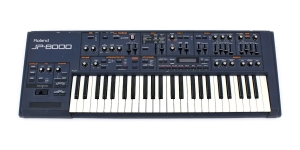 In 1996 a gorgeous Roland JP-8000 was demonstrated (appeared on the shelves in 1997) – the instrument was considered to be a Jupiter-8/Jupiter-6 substitute and marked a “supersaw” era: synths started to offer that famous feature of stacked detuned sine waveforms. Thanks to supersaw popularity back then this synthesizer is still a worthy purchase despite some filter and envelope generator drawbacks which actually were a part of any analog modeling synthesizer when they just appeared.
In 1996 a gorgeous Roland JP-8000 was demonstrated (appeared on the shelves in 1997) – the instrument was considered to be a Jupiter-8/Jupiter-6 substitute and marked a “supersaw” era: synths started to offer that famous feature of stacked detuned sine waveforms. Thanks to supersaw popularity back then this synthesizer is still a worthy purchase despite some filter and envelope generator drawbacks which actually were a part of any analog modeling synthesizer when they just appeared.
It’s interesting that compering to nowadays situation on the musical instrument market and an obvious domination of the great Japanese trio – in the mid-1990s European companies were considerable enough to compete with them, just think of, for example, a young (at that time) German brand called Access Music GmbH who launched their prominent and highly successful Virus series analog synthesizers in 1997.
Some analog modeling synthesizers also had their rackmount versions (Nord Rack, Yamaha CS6r, Roland JP-8080).
Here we’ll talk about modern day synthesizers each of which was created with a certain individual approach to such kind of technologies – the priorities were made clear in order not to go against the brand policy of each manufacturer.
KingKORG
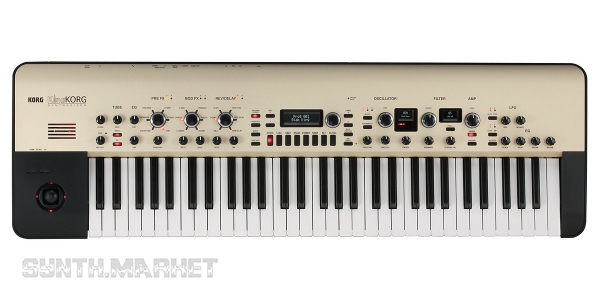 Korg called their method XMT (eXpanded Modelling Technology) – it’s a new development step in MMT (Multiple Modelling Technology) which Radias, R3 and MicroKorg were based on. XMT implies a modeling sound engine producing a wide range of tonal variations. KingKORG is loaded with algorithms carrying the combinations of different types and number of generators which simplifies the process and gives out so many results which couldn’t be achieved by setting and adjusting each oscillator independently. The oscillator algorithms generate standard waveforms and noise besides which there are also extra PCM samples and DWGS algorithms in the architecture of the synth.
Korg called their method XMT (eXpanded Modelling Technology) – it’s a new development step in MMT (Multiple Modelling Technology) which Radias, R3 and MicroKorg were based on. XMT implies a modeling sound engine producing a wide range of tonal variations. KingKORG is loaded with algorithms carrying the combinations of different types and number of generators which simplifies the process and gives out so many results which couldn’t be achieved by setting and adjusting each oscillator independently. The oscillator algorithms generate standard waveforms and noise besides which there are also extra PCM samples and DWGS algorithms in the architecture of the synth.
KingKORG offers an initial choice of 126 waveforms: 32 of analog origin, 64 DWGS waveforms (Digital Waveform Generator System was devised by Korg in the 1980s – the era of a serious digital competition with Yamaha DX7) and 30 PCM (Pulse Code Modulation) samples. Having adjusted the parameters you could transform analog waves into supersaw or PWM ones. DWGS waveforms are actually dual oscillators which you can apply some detune to or make them a VPM (Variable Phase Modulation) subject in order to create the new set of various sounds. PCM samples are presented with a useful “tool kit” of derivative waveforms of any type. It’s worth mentioning that the synthesizer is bi-timbral and allows you to split the keyboard into 2 zones featuring different sounds.
Analog modeling technology has also affected the filter section offering 18 modes 5 of which were developed specially for KingKORG and others were modeled based on filters of the famous synthesizers among which there are Minimoog, Prophet 5, SEM, MS-20 and TB-303.
The modulation matrix offers 6 “virtual patches” with 12 sources: 2 envelope generators, 2 LFOs (each of which has 7 waveforms including random function as well as sample&hold, frequency range from 0.01 Hz to 100 Hz), a 2 axis joystick (Y+ and Y- as different sources), intensity, key tracking, possibility of connecting 3 MIDI controllers – there are 41 destinations for all this.
Despite the sound of great quality which copies analog synthesizer voices KingKORG wasn’t too commercially successful and you can find a lot of good reviews proving the bad market situation wrong or at least unfair. The synthesizer is truly underrated but we’re sure that it is capable of so many things both on stage and in a studio and the only flaw is the lack of a built-in sequencer. We think it would serve you right as solo synth due to separate voice outputs missing (just one dual stereo 1.4''/ 6.3 mm). There is one CV/Gate output and KingKORG can send signals to external synthesizers but there are no CV inputs so it can serve as a slave synth only via MIDI. As well as microKORG instruments KingKORG offers a vocoder function and XLR microphone input.
Any beginner can manage the interface – the front panel includes encoders for each basic function as well as 3 monochrome text displays – the main one and 2 extra ones. All the controllers are divided into groups and provide a good layout: effect section; timbre section, split and arpeggio; a big section for oscillator control with a separate screen; filter and amplifier section (with an assigned display as well), LFO and ADSR envelope generators.
The experts shouldn’t be scared away with a seemingly fragile construction – KingKORG is difficult to harm and is as invulnerable as its creators ignoring the jokes about the name. The chassis and aluminum front panel are its solid elements, as for flimsy plastic and a budget keyboard – well, KingKORG wasn’t planned to be a professional piano for an expert but if you think that external power supply is definitely kind of lame so we advise you to try to focus on the strengths of the instrument – and there are enough of them.
Many salute the depth of its sonic palette – not only sounds but the possibility to combine analog waveforms with PCM samples, use 3 tones in one “Timbre” (in other words there are 3 oscillators per voice) doing whatever you wish to: you can take 2 different synth tones, detune them, add a sampled instrument layer and with no need to dig the menu put them through the effects meeting all the quality requirements (among effects there is a great tube one thanks to featuring the real tube). Korg wasn’t willing to replace neither DW8000 nor Space Echo or other top analog synthesizers with it and it might be that in some studio KingKORG would be kept aside – waiting to be taken in tour and watching all those huge war-horses and monofunctional devices stacked upon each other left and locked at home. The price might be the matter - $1000 is a bit higher of the tag some close competitors offer. The new version with a black front panel is announced – KingKORG BK.
Clavia Nord Lead 4
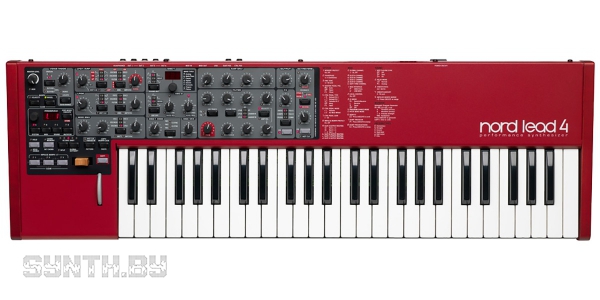 Though there is no Clavia Nord Lead 4 among those affordable synthesizers because it costs twice more - $2000. The very concept called “virtual analog” appeared thanks to Nord Lead in 1995. It was a good time for samplers, it was hard for analog devices which were losing their target audience and even harder for expensive emulation technologies. We think that Nord Lead wasn’t actually the first – at that time Japan was into creating quite the same analog modeling synthesizers with similar functions - Roland JP-8000, Yamaha CS1x, Korg Z1 – and, of course, you cannot create something like that in a short time having no technical background.
Though there is no Clavia Nord Lead 4 among those affordable synthesizers because it costs twice more - $2000. The very concept called “virtual analog” appeared thanks to Nord Lead in 1995. It was a good time for samplers, it was hard for analog devices which were losing their target audience and even harder for expensive emulation technologies. We think that Nord Lead wasn’t actually the first – at that time Japan was into creating quite the same analog modeling synthesizers with similar functions - Roland JP-8000, Yamaha CS1x, Korg Z1 – and, of course, you cannot create something like that in a short time having no technical background.
Though let’s get back to Nord Lead. Besides the modeling technology which just started to gain popularity the instrument offered another rare peculiarity – control panel with loads of real time control knobs.
Its contemporary successor Nord Lead 4 has oscillators sporting the architecture remaining from the previous models though excluding the wave shaping feature offered in Nord Lead 3. Clavia increased the number of digital waveforms for Osc 1 up to 128 (kind of those the classic PPG and Korg DW synthesizers generated). Osc 2 was sort of a noise generator for the extra waveforms produced by the first oscillator. Lead 4 lost ring modulation but offered 3 FM modes which were actually closer to cross modulation. The filter offered 7 modes among which there were 2-pole and 4-pole as well as Minimoog and Roland TB-303 emulation; 4 key tracking levels and a touch sensitive bipolar contour generator ADSR.
The synthesizer features nice Split&Layer capabilities which allow creation up to 4 sound layers each of which has individual effect settings as well as a separate audio signal output 1.4'' per layer. Layers can be used together resulting in a juicy multitimbral sound or assigned as 4 different keyboard zones in order to give various complementing voices. Arpeggiator patterns and LFO will help to receive endless sound wave variations without the need of running through the keys at the speed of a piano virtuoso.
Lead 4 is the first synthesizer in the series which got the section of built-in effects, such as: overdrive, compressor, bit crusher and two types of formant effects. Macro control function which allows a source to modulate several parameters simultaneously was called “Morph” by Clavia – it was responsible for such settings as vibrato depth or reverberation intensity. Impulse Morph lets you to assign several parameter changes at a time (sound wave transformation) for a filter or effects, just to one press of a button or a pedal as well as to a mod wheel (for further trigger during live performances). Nord Lead 4 has another interesting possibility – a program generator “Mutator” which initially takes a program and then transforms it to a certain extent (a user chooses the intensity) – as a result you get a completely new program with absolutely different texture.
Nord Lead 4 has a $2300 price tag, so it could have spent more on the keyboard part but Clavia keeps on contributing to its unconventionally peculiar control zone which allows you to twist and spin the sound any way you like. Many of those who tested Lead 4 got addicted to arpeggiator possibilities and to the sound as well believing that among same range virtual analog synths Nord imitates electric circuits in the best possible way – even some retro synthesizers from the 1980s could be replaced by Lead 4 without any serious damage of that vintage vibration.
If you really want to try the instruments by the Swedish company and wish you didn’t have to spend money – Clavia’s got something to offer: Nord Lead A1. It will cost you $1800 and it’s barely excelled by its high-and-mighty brother – the only difference is that it offers simpler envelope generators ADR/ASR instead of ADSR, fewer LFO and FM capabilities and its main oscillator lacks PWM. At the same time Lead A1 has amplitude modulation feature (AM) which is missing in Lead 4 and even surpasses it in polyphony – 26 voices vs 20.
Studiologic Sledge
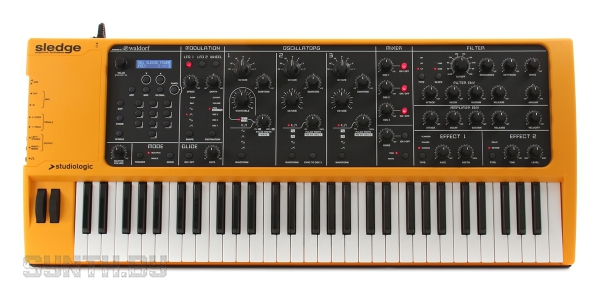 Anyway Studiologic Sledge doesn’t fit this “same range analog synthesizer” row. It has its own distinctive features, it’s actually too unique to be compared (even the basic connectivity occupies the side panel instead of the rear one). Considering that Studiologic belongs to an Italian key making company Fatar it’s no surprise that the keyboard is out of the cost issue – Studiologic puts quite a moderate price on the velocity sensitive keyboard with aftertouch. The construction carries the German filling – Sledge is based on the Waldorf designs and developments sporting an altered and elaborated Blofeld sound engine. One of the clear weaknesses of the instrument is its timbrality (splitting, layering), but the funny thing is that Sledge turns all the seeming drawbacks into uniqueness – there are no possibility of compound effect creation as well as deep programming features. Sledge backed out of competition.
Anyway Studiologic Sledge doesn’t fit this “same range analog synthesizer” row. It has its own distinctive features, it’s actually too unique to be compared (even the basic connectivity occupies the side panel instead of the rear one). Considering that Studiologic belongs to an Italian key making company Fatar it’s no surprise that the keyboard is out of the cost issue – Studiologic puts quite a moderate price on the velocity sensitive keyboard with aftertouch. The construction carries the German filling – Sledge is based on the Waldorf designs and developments sporting an altered and elaborated Blofeld sound engine. One of the clear weaknesses of the instrument is its timbrality (splitting, layering), but the funny thing is that Sledge turns all the seeming drawbacks into uniqueness – there are no possibility of compound effect creation as well as deep programming features. Sledge backed out of competition.
Studiologic released a thing-in-itself so that you wouldn’t and simply couldn’t compare it to anything else. Although there are some nice user-friendly functions such as “one function per button” approach. M-Audio Venom comes to mind: you’ll just have to connect it to the computer via USB in order to get all the potential out of the instrument, or take for example Waldorf Blofeld of the same core – it offers an austere dull interface.
Initially Sledge was a monotimbral synthesizer with an 8-voice polyphony though later it was updated to 16 voices. Besides wavetable synthesis there was also a traditional subtractive synthesis introduced – 3 oscillators per note, sync, cross modulation and noise generator. The list of fundamental features includes multimode resonant filter, audio amplifier (each with its own ADSR), 3 LFOs assigned to 8 destinations, polyphonic portamento, several poly and mono modes, 2 effect sections: chorus/phaser/flanger + delay/reverb.
The documentation says that wavetables directly originate from iconic PPG Wave 2.3 but we need to emphasize that PPG offers 32 wavetables 64 waveforms each while Sledge features 66 – 100 variations each, that’s why it’s difficult to compare PPG/Waldorf engine with wavetable synthesis of Studiologic, there are some evident blank spaces. Anyway we can affirm that Sledge is much more programmable though it gives way to the famous wavetable giants by PPG and their successors by Waldorf regarding possibilities. The control panel features a big knob in an Osc 1 section for table option, then you can choose a waveform with the help of PW knob which is automatically re-assigned when you switch into wavetable operation mode. Within the wavetable you can play with LFO and, which is truly amusing, a ramp generator. Studiologic Sledge grasped the proven basics of the popular synthesis type and turned it into entertainment without any violation of the concept devised 30 years ago by German engineers.
In 2014 Sledge got a successor – Sledge 2.0. Its main difference is in a 24-voice polyphony and bitimbrality which will seem crucial specification details in Auto Dual mode and simultaneous reverb and delay as well as an expanded flash memory up to 60 Mb which allows to upload samples and create sounds from scratch.
Those who’re not nostalgic about the yellow school bus color and took it as a primary reason to reject Sledge with a sad sigh were invoked in 2016: Studiologic drew their attention one more time trying to lure them with the Black Edition version of the unit. Not only panels were black but also the “newly weighted” and improved keys were painted the darkest of the colors. The company promised elaborate modulation functions and sounds as well as the mix of the pure synthesis and sampling.
The cost of the synthesizer of the basic configuration within an orange construction is $800, Black Edition - $1000. If you desire to get more paying less then you have a great gear choice - Studiologic Sledge 2.
Access Virus
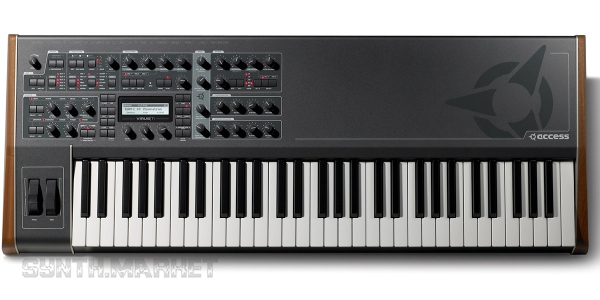 There’s probably not a musician out there who wouldn’t want to purchase Access Virus – at least everyone’s ever imagined what it’d be like to work with it. Virus TI architecture was thoroughly revised after previous Virus units were released. Total Integration version comprised an engine featuring double DSP configuration with an accelerated processing the power of which was in the number of voices as well – 80 in moderate use conditions. But the number of voices directly depended on the intensity of the patches – effects and the number of oscillators applied. TI2 (unlike TI) doesn’t conceal in its documentation a polyphony subjection to a patch (voices vary from 20 to 90). Virus TI2 is an analog modeling synthesizer with 61 semi-weighted keys, 3000 factory patches and memory for 500 user patches. The new version increased the processor power by 25%, added a tape delay, frequency shifter and 6 new distortion types which emulated vintage distortion pedals effect. TI2 achieves a convincing analog waveforms behavior by the double digital signal processing engine which gives unlimited tonal combinations while modeling various oscillators and filter types sculpting a sound stream with 3 LFOs, 68 waveforms, 2 envelope generators for filter and up to 192 simultaneous effects.
There’s probably not a musician out there who wouldn’t want to purchase Access Virus – at least everyone’s ever imagined what it’d be like to work with it. Virus TI architecture was thoroughly revised after previous Virus units were released. Total Integration version comprised an engine featuring double DSP configuration with an accelerated processing the power of which was in the number of voices as well – 80 in moderate use conditions. But the number of voices directly depended on the intensity of the patches – effects and the number of oscillators applied. TI2 (unlike TI) doesn’t conceal in its documentation a polyphony subjection to a patch (voices vary from 20 to 90). Virus TI2 is an analog modeling synthesizer with 61 semi-weighted keys, 3000 factory patches and memory for 500 user patches. The new version increased the processor power by 25%, added a tape delay, frequency shifter and 6 new distortion types which emulated vintage distortion pedals effect. TI2 achieves a convincing analog waveforms behavior by the double digital signal processing engine which gives unlimited tonal combinations while modeling various oscillators and filter types sculpting a sound stream with 3 LFOs, 68 waveforms, 2 envelope generators for filter and up to 192 simultaneous effects.
The oscillator operates in the modes of virtual analog (continuously variable wave shaping sine/square, applying pulse-width modulation), wavetables (starting from TI series), hypersaw, graintable (granular synthesis – samples are split into small pieces of around 1 to 50 ms which are called grains, they can be layered on top of each other, can play at different speeds, phases, volume, and frequency, among other parameters) and formant table.
That’s how TI line differs from previous Viruses: two Motorola DSP integrated circuits instead of one and, of course, more developed emulation capabilities due to wavetable synthesis inclusion and hypersaw mode. Comparing to other virtual analog instruments like Clavia Nord Lead and Roland JP-8000 oscillators in Virus don’t emphasize too much upper range frequencies which actually makes them tinctured with gloom feel. One of the distinctive features can be considered a dual multimode resonant filter which can function in series and parallel or be assigned to process both oscillators. Among characteristics there is an extensive modulation matrix which allows auto modulation of variables (for example, an envelope generator can be a source and a mod destination at a time).
A bad review on Virus – is something pretty much ridiculous and rare as well. Virus TI2 provides analog emulation and frankly synthesized voices of the same high quality, it offers you so many sound manipulation possibilities you won’t resist.
Access Virus TI2 will cost you starting at $2200 price (desktop module) and ending at $3000 for a keyboard version TI2 Keyboard/ TI2 Polar – they are still on sale but soon they might disappear.
Novation Ultranova
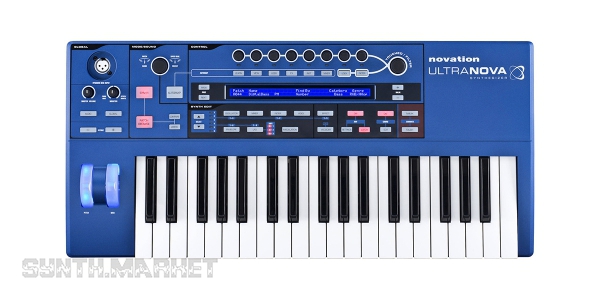 Novation Ultranova is based on the synthesis of the respectable Supernova II but apart from analog modeled waveforms there is a choice of 20 digital waves (re-created/non-sampled) compensating the lack of FM. Besides, each oscillator is equipped with 36 wavetables (9 waveforms per each) which is out of competition with Waldorf or Access but it’s definitely not an ersatz product either: interpolation varies transitions between adjacent waveforms any way you want – it can be smooth and subtle or sudden and interrupted.
Novation Ultranova is based on the synthesis of the respectable Supernova II but apart from analog modeled waveforms there is a choice of 20 digital waves (re-created/non-sampled) compensating the lack of FM. Besides, each oscillator is equipped with 36 wavetables (9 waveforms per each) which is out of competition with Waldorf or Access but it’s definitely not an ersatz product either: interpolation varies transitions between adjacent waveforms any way you want – it can be smooth and subtle or sudden and interrupted.
On the whole the synthesis architecture in Ultranova involves 3 oscillators, 3 LFOs (the 4th one for vibrato), 6 envelope generators, 2 filters (14 types each), a chain of 5 effects and a 20-slot modulation matrix.
Each oscillator has a hidden one inside which serves virtual sync needs and that’s how already shining sounds can be made more complex by layering of the synced tones.
Ultranova is great for electro-pop, dubstep and trance musicians with its accent on building own unique sounds and first of all sound for the genres which require deep thick bass. Touch-philosophy of Ultranova is in extremely responsible rotary encoders which allow a quick access to the functions often hidden in other synthesizers. The innovative brand technology Automap lets you easily turn the instrument into a master-keyboard while connected to any DAW thanks to automated settings. Besides, the synthesizer can be applied as a vocoder and offers a built-in audio interface with 24 bit 96khz resolution and a digital output.
The price tag for Novation Ultranova is about $550-600.
Roland Gaia SH-01
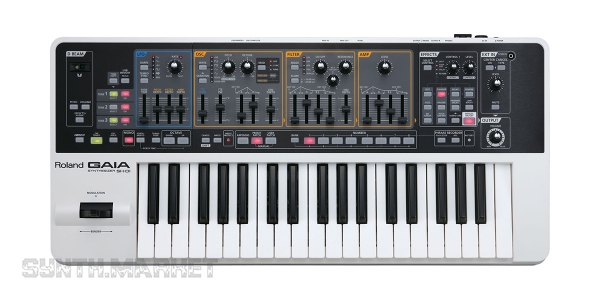 In 1996 Roland launched an analog modeling JP-8000 which is still highly valued in spite of having some flaws. The Japanese corporation kept on developing and using analog modeling technologies just as components of the sound engines for “heaped up” superfine digital synthesizers such as Roland V-Synth instruments or Fantom workstations (Fantom-X, Fantom-G). In 2006 the situation changed thanks to SH-201 which was quite a standard example of an analog modeling synthesizer clearly showing the desire of the manufacturer to cut down expenses – and that affected the actual selling. Later Gaia SH-01 drew attention to itself featuring a smart approach to the synthesis and a nice and simple use.
In 1996 Roland launched an analog modeling JP-8000 which is still highly valued in spite of having some flaws. The Japanese corporation kept on developing and using analog modeling technologies just as components of the sound engines for “heaped up” superfine digital synthesizers such as Roland V-Synth instruments or Fantom workstations (Fantom-X, Fantom-G). In 2006 the situation changed thanks to SH-201 which was quite a standard example of an analog modeling synthesizer clearly showing the desire of the manufacturer to cut down expenses – and that affected the actual selling. Later Gaia SH-01 drew attention to itself featuring a smart approach to the synthesis and a nice and simple use.
Gaia structure comprises 3 oscillators (7 waveforms each; 3 variations per wave = 21 waveform per oscillator) providing tuning, sync, ring modulation and AD envelope generator here in the oscillator section. Gaia is unique: physically it has just one generator, one filter, one amplifier and one LFO but in reality Roland triples the structure of each section allowing them to be virtually layered. There is no splitting option which is probably due to simplify the system or because of a compact 3-octave keyboard.
Unlike the instruments where first the oscillators get mixed and after the sound goes through the filter and amplifier section, in Gaia each oscillator has its own filter, amplifier and LFO and as a result we get amusing patches.
Gaia offers a surprisingly big polyphony for a modeling synthesizer – 64 voices vs 8 voices in JP-8000 which can be explained only with an enigmatic integrated circuit of the “new generation” sporting more powerful processing specs.
Among the waveforms of the analog origin there’s that famous brand supersaw: even within just one active tone the simulation of 7 slightly detuned sawtooth waveforms splash in a lush, luxuriant unison. SH-01 transmits the whole range of analog noises – from warm strings with a soft texture and shimmering arpeggio to heavy bass and modern saturated sounds.
Gaia sets you free from intuitive guessing and confused control making every sound production step clear thanks to the helpful and well-thought layout which is considered to be one of the most comprehensible and logical ones among all the subtractive synthesizers.
Roland Gaia SH-01 costs about $600 and is almost ready to quit the market giving way to new Roland synthesizers with a more flexible architecture.
Roland System 8
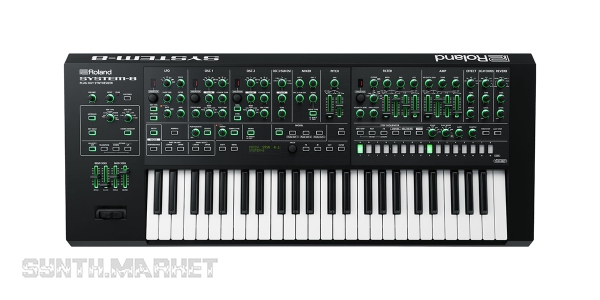 Roland is followed by Roland – not a rare thing for a list featuring top synths. Now the company’s presented by System-8 announced not so long ago where the analog modeling technology of the Analog Circuit Behavior engine hits the new level. System-8 offers a sufficient number of initial sounds for creation but the most prominent part of its structure is Plug-out models, i.e. the possibility to upload 3 Plug-out models – sound engines of the other synthesizers (such as SH-101, SH-2, ProMars) while Jupiter-8 and Juno-106 models are already factory included. 3 Plug-out buttons let you switch sound models immediately and in Performance mode you can combine the original sounds of System-8 with uploaded ones provided by Plug-out function – so you could create hybrid fat sonic sandwiches.
Roland is followed by Roland – not a rare thing for a list featuring top synths. Now the company’s presented by System-8 announced not so long ago where the analog modeling technology of the Analog Circuit Behavior engine hits the new level. System-8 offers a sufficient number of initial sounds for creation but the most prominent part of its structure is Plug-out models, i.e. the possibility to upload 3 Plug-out models – sound engines of the other synthesizers (such as SH-101, SH-2, ProMars) while Jupiter-8 and Juno-106 models are already factory included. 3 Plug-out buttons let you switch sound models immediately and in Performance mode you can combine the original sounds of System-8 with uploaded ones provided by Plug-out function – so you could create hybrid fat sonic sandwiches.
The actual engine within a System-8 own structure comprises 2 oscillators (6 waveforms each + 2 variations per wave) and a third oscillator generating sine and triangle also serving as a sub oscillator. Noise generator produces white and pink noise. Each oscillator has several modulation sources including LFO, pitch, envelope generators assigned to filter and amplifier. System-8 offers an 8-voice polyphony. Another interesting feature is the extremely precise parameter copy of those in original instruments which are re-created – when you activate one of the sound models (Plug-outs) its sound engine doesn’t use any of the functions which weren’t comprised in the original synth; and the front panel – in order to make it even more authentic – deactivates and switches off the respective controllers (which weren’t featured in a chosen model).
Thanks to Plug-out support the filter section can be quite diverse modeling filters of the other brand lines.
Today Roland System-8 will cost you approximately $1500 though we can argue that in a year it will cost $1200-1300 and we’re not talking about a second hand unit. If we pay attention to the actual purpose of the synth – everything speaks in favor of System-8, musicians will opt for it crowning the synthesizer and maybe even putting it at the top of the list. Why would you think? The answer is simple and we’ve got 3 reasons to prove it not even mentioning its nice price. First – sequencer. Second – sounds of truly good quality which perfectly imitate the legendary Jupiter-8, Juno-106 and other Roland synthesizers. Third – wide range of connectivity possibilities as well as being smoothly compatible with AIRA instruments and other synthesizers. To cut it short – this is a nowadays JP-8000.
Some virtual analog synths were left backstage in our review only because we’re saving them for the future and upcoming articles. We’ll pay tribute to such mega synths as John Bowen Synth Design Solaris and Arturia Origin, both of them deserving an honorable mention, a couple of pages at least, and catching in a unique way Radikal Technologies Accelerator, Waldorf Blofeld, Novation MiniNova/ MoroderNova, microKORG family, Roland System-1, Roland Boutique series, prematurely discontinued M-Audio Venom and others.
